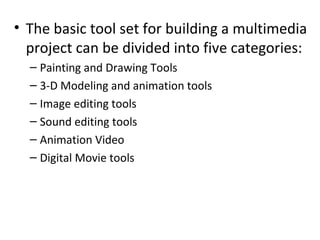Image editing tools in multimedia are software applications used to manipulate, enhance, and transform images. These tools cater to various needs, from basic touch-ups to advanced graphic design.
Image editing tools play a crucial role in multimedia by enabling users to create visually appealing content. These tools range from simple applications like Microsoft Paint to advanced software like Adobe Photoshop. They offer features such as cropping, resizing, color correction, and special effects.
With these functionalities, users can improve the quality of images, making them more engaging and professional. These tools are indispensable in fields like digital marketing, web design, and content creation, where visual appeal significantly impacts audience engagement and retention.
Introduction To Image Editing Tools
Image editing tools are essential in multimedia. They help enhance and modify images. These tools are used in various fields like photography, graphic design, and web development.
The Role In Multimedia
Image editing tools play a crucial role in multimedia. They allow creators to manipulate images for better visual communication. With these tools, you can adjust colors, remove flaws, and add special effects.
They make it easier to create engaging content. This helps in grabbing the audience’s attention. These tools are vital for marketing, advertising, and social media.
Brief History
The history of image editing tools dates back to the 1980s. The first digital editing software was developed during this time. Adobe Photoshop, launched in 1988, revolutionized image editing.
Earlier, editing images was a manual process. It involved physical alteration of photographs. Digital tools have made the process faster and more efficient. Over the years, many advanced tools have been introduced.
| Year | Tool | Significance |
|---|---|---|
| 1988 | Adobe Photoshop | Revolutionized digital image editing |
| 1991 | GIMP | Open-source alternative to Photoshop |
| 2003 | Adobe Lightroom | Streamlined photo management and editing |
- Enhance image quality
- Remove unwanted elements
- Add artistic effects
- Open the image editing software
- Upload the image
- Apply desired changes
- Save the edited image
Key Features Of Image Editing Software
Image editing tools are essential in multimedia creation. They provide various functionalities to enhance and manipulate images. Below are some key features of image editing software that make them invaluable for professionals and hobbyists alike.
Layers And Masks
Layers and masks are crucial features of image editing software. Layers allow you to stack different elements in an image. This enables you to edit each element without affecting others. Masks help control the transparency of layers. They let you hide or reveal parts of the image. This feature is important for complex edits and composites.
Filters And Effects
Filters and effects enhance the visual appeal of your images. Filters can adjust colors, lighting, and textures. They can make images look vintage or modern. Effects add artistic touches. Examples include blurs, glows, and shadows. These tools help in transforming ordinary photos into extraordinary works of art.
Popular Image Editing Tools
Image editing tools are essential in multimedia. They help in creating and enhancing visuals. Let’s explore some popular image editing tools that professionals and enthusiasts use.
Adobe Photoshop
Adobe Photoshop is a powerful image editing software. It offers a wide range of features. You can use it for photo retouching, image composition, and more.
- Layers and masks for complex edits
- Advanced color correction tools
- Wide range of filters and effects
- Integration with other Adobe products
Photoshop is known for its versatility. It is suitable for both beginners and experts.
Gimp
GIMP stands for GNU Image Manipulation Program. It is a free and open-source image editor. GIMP is a great alternative to Photoshop.
- Customizable interface
- Support for various file formats
- Advanced photo retouching tools
- Extensible through plugins and extensions
GIMP is ideal for users who need powerful tools without the cost.
Coreldraw
CorelDRAW is a vector graphics editor. It is perfect for creating logos, brochures, and other vector-based designs.
- Intuitive user interface
- Advanced vector editing tools
- Support for multi-page documents
- Powerful typography tools
CorelDRAW is popular among graphic designers. It offers precise control over designs.
| Tool | Key Features | Best For |
|---|---|---|
| Adobe Photoshop | Layers, masks, color correction, filters | Photo retouching, complex image edits |
| GIMP | Customizable, supports various formats, plugins | Free image editing, advanced retouching |
| CorelDRAW | Vector editing, multi-page support, typography | Vector designs, logos, brochures |

Credit: www.slideshare.net
Comparing Professional Vs. Free Tools
Image editing tools are vital in multimedia. Choosing between professional and free tools can be tough. Let’s compare their features, interfaces, and support options.
Functionality
Professional tools offer a vast range of features. They support advanced edits and high-quality output. Free tools often have basic functions. They are good for simple edits.
| Feature | Professional Tools | Free Tools |
|---|---|---|
| Layers | Yes | No |
| Filters | Extensive | Limited |
| File Formats | Multiple | Few |
| Custom Brushes | Yes | No |
User Interface
Professional tools have a complex interface. They need a learning curve. Free tools are simpler. They are easy for beginners.
- Professional tools have more icons and menus.
- Free tools have fewer options on the screen.
- Professional tools can be overwhelming at first.
- Free tools are straightforward to use.
Support And Resources
Professional tools offer extensive support. They have tutorials and forums. Free tools have limited support. They rely on community help.
- Professional tools provide customer service.
- They have detailed user guides.
- Free tools offer basic FAQs.
- Free tools depend on user forums.
Professional tools have regular updates. Free tools may not update often.
Understanding File Formats
Image editing tools are essential in multimedia. They help in refining images. But understanding file formats is crucial. Different formats serve different purposes. Knowing which to use can make a big difference.
Jpeg Vs. Png
JPEG and PNG are common image formats. Both have unique features. JPEG is best for photos. It compresses well, saving space. But it loses some quality. This loss is called lossy compression.
PNG is different. It uses lossless compression. This means no quality loss. PNG is great for images with text. It also supports transparency. But PNG files are larger than JPEGs.
| Feature | JPEG | PNG |
|---|---|---|
| Compression | Lossy | Lossless |
| Best for | Photos | Images with text, transparency |
| File Size | Smaller | Larger |
Raw Files
RAW files are unprocessed images. They contain all the data from the camera sensor. This makes them very large. But they offer the best quality. Photographers love RAW files. They can edit them without losing quality.
Editing RAW files needs special software. Examples include Adobe Lightroom and Photoshop. RAW files can be converted to other formats later.
- High quality
- Large file size
- Need special software
Understanding these file formats helps in choosing the right one. This ensures the best results for your images.

Credit: www.researchgate.net
The Process Of Image Editing
The process of image editing is an essential part of multimedia. It involves adjusting and enhancing images to make them more appealing. This process is used in various fields like photography, advertising, and web design. With the right image editing tools, you can transform ordinary images into stunning visual content.
Basic Steps
The basic steps of image editing are simple yet effective. Here are the fundamental steps:
- Import the Image: Open the image in your editing software.
- Cropping: Remove unwanted parts of the image.
- Adjust Brightness and Contrast: Make the image brighter or darker.
- Color Correction: Adjust the colors for better balance.
- Sharpening: Enhance the details of the image.
- Saving: Save the edited image in the desired format.
Advanced Techniques
For professional results, advanced techniques are essential. Below are some advanced editing methods:
- Layering: Use layers to manage different parts of the image separately.
- Masking: Hide or reveal parts of the image without permanent changes.
- Blending Modes: Combine layers for unique effects.
- Retouching: Remove blemishes and imperfections.
- Filters and Effects: Apply special filters for artistic effects.
- Vector Graphics: Create and edit scalable images.
Below is a table summarizing some popular image editing tools and their features:
| Tool | Features |
|---|---|
| Adobe Photoshop | Layering, masking, filters, vector graphics |
| GIMP | Open source, layering, color correction |
| CorelDRAW | Vector graphics, layout tools, photo editing |
| Canva | Templates, easy-to-use, online platform |
Mastering the process of image editing will enhance your multimedia projects. Whether you are a beginner or an expert, using the right tools and techniques is key.
Creative Uses Of Image Editing
Image editing tools offer endless creative possibilities. You can transform ordinary photos into stunning visuals. These tools help artists and photographers bring their imagination to life. Let’s explore some exciting ways to use these tools.
Digital Art
Digital art is a popular use of image editing tools. Artists can create vibrant paintings without traditional materials. Tools like Photoshop offer brushes and textures. These tools mimic real-world painting techniques. Artists can experiment with colors and styles easily.
Creating digital art is less messy. It also allows for easy corrections. Artists can undo mistakes with a simple click. This flexibility encourages creativity and innovation. Digital art can be shared online instantly. This helps artists reach a wider audience.
Photo Restoration
Photo restoration is another creative use. Old photos can fade or get damaged. Image editing tools can bring them back to life. Tools can fix scratches and tears. They can also adjust colors and brightness.
Restoring photos preserves memories. It helps keep family history alive. Professionals use advanced techniques for restoration. But even beginners can start with simple tools. Many software options offer user-friendly interfaces.
Here’s a simple table illustrating common tools for photo restoration:
| Tool | Function |
|---|---|
| Clone Stamp | Repairs damaged areas |
| Healing Brush | Blends imperfections |
| Color Correction | Adjusts faded colors |
With these tools, anyone can restore cherished photos. Editing software makes it easy to fix and improve old images.
Future Trends In Image Editing
Image editing tools in multimedia are evolving rapidly. New technologies are transforming the way we edit images. These tools are becoming smarter, faster, and more accessible. Let’s explore two key trends shaping the future of image editing.
Ai And Machine Learning
Artificial Intelligence (AI) and Machine Learning (ML) are changing image editing. These technologies make editing more intuitive and powerful. AI can automatically enhance images, remove backgrounds, and even add missing details.
Machine Learning algorithms can analyze millions of images. They learn patterns and styles to make better editing decisions. This results in more accurate and creative edits.
Here are some exciting features AI and ML bring to image editing:
- Automated color correction
- Smart object removal
- Style transfer and filters
- Facial recognition and enhancement
Cloud-based Editing
Cloud-based editing tools are growing in popularity. These tools allow users to edit images from anywhere. All you need is an internet connection.
Cloud-based tools offer several advantages:
| Feature | Benefit |
|---|---|
| Accessibility | Edit images on any device |
| Collaboration | Work with teams in real-time |
| Storage | Save space on local devices |
| Updates | Instant access to new features |
Cloud-based editing also ensures your projects are safe. They are stored securely in the cloud. This reduces the risk of losing important files.

Credit: slideplayer.com
Frequently Asked Questions
What Is The Most Common Photo Editing Tool Used?
The most common photo editing tool used is Adobe Photoshop. It’s popular for its advanced features and user-friendly interface.
What Is The Purpose Of Image Editing?
The purpose of image editing is to enhance visual appeal, correct flaws, and improve overall quality. It can also help in emphasizing key elements, ensuring better communication and engagement.
What Is An Image Editor With An Example?
An image editor is software for editing digital images. Example: Adobe Photoshop allows users to enhance and manipulate photos easily.
What Are The Basics Of Image Editing?
Image editing basics include cropping, resizing, adjusting brightness and contrast, color correction, and removing blemishes. Use tools like Photoshop or GIMP.
Conclusion
Image editing tools are essential for multimedia professionals. They enhance visuals, improve clarity, and boost engagement. These tools offer versatility, making content more appealing and professional. As technology advances, mastering these tools becomes crucial. Embrace image editing to elevate your multimedia projects and stay ahead in the digital landscape.







